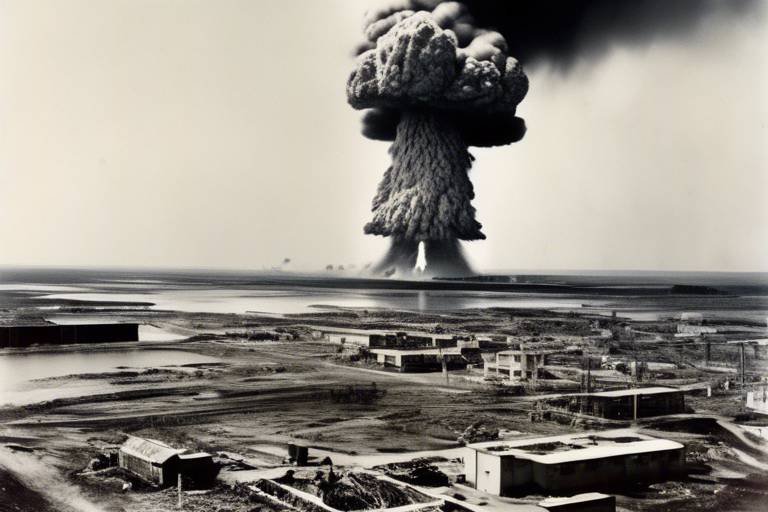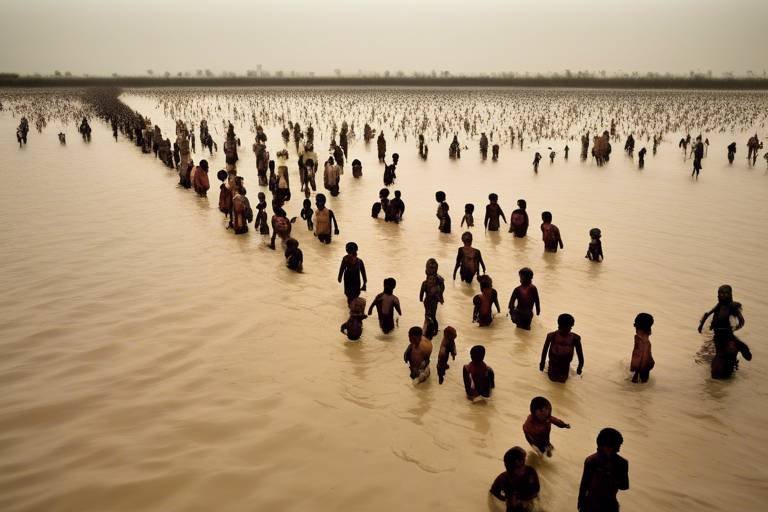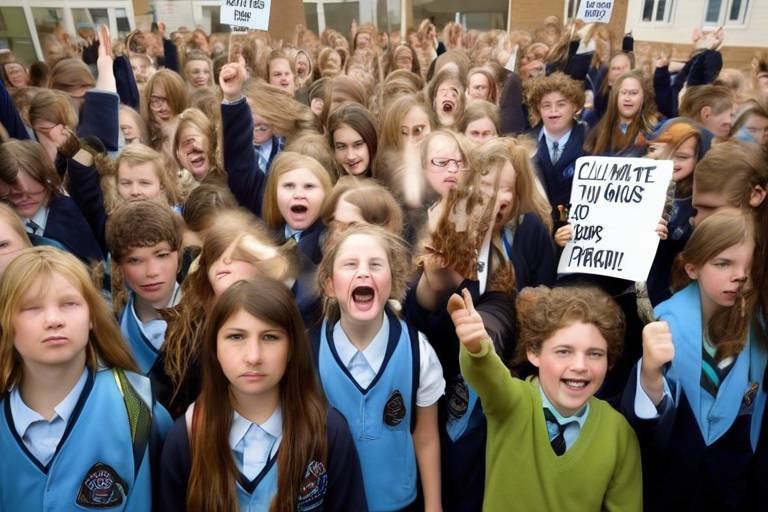Climate Change: The Hidden Cost of Fast Fashion
Fast fashion has taken the world by storm, offering trendy clothing at jaw-dropping prices. But have you ever stopped to think about the hidden costs behind those bargains? The reality is that the environmental impact of fast fashion is staggering, contributing significantly to climate change, resource depletion, and pollution. As consumers, we often overlook the consequences of our shopping habits, but it’s time to shine a light on these issues and understand the urgent need for sustainable practices in the fashion industry.
Fast fashion significantly contributes to environmental degradation through excessive waste, water pollution, and carbon emissions. The fashion industry is one of the largest polluters globally, and its impact is felt in every corner of the planet. For instance, did you know that the production of a single t-shirt can require up to 2,700 liters of water? That’s enough for one person to drink for two and a half years! Understanding these impacts is crucial for recognizing the urgent need for sustainable practices in the fashion industry.
The fast fashion industry heavily relies on finite resources, leading to significant depletion. The materials used in clothing, such as cotton, polyester, and leather, often come from unsustainable sources that strain our planet's natural resources. As we continue to demand cheap and trendy clothing, we are essentially depleting vital resources faster than they can be replenished. This section discusses the long-term implications for the planet's natural resources and why we must rethink our consumption patterns.
Water is a critical resource in fashion production, and fast fashion brands consume vast amounts. The processes involved in dyeing, finishing, and washing garments are notoriously water-intensive. For example, the dyeing process alone can use up to 200 tons of water per ton of fabric produced. This excessive consumption not only strains local water supplies but also leads to pollution, as toxic chemicals from dyeing often end up in rivers and streams, affecting both wildlife and communities living nearby.
Fast fashion's water consumption often leads to scarcity in local communities, particularly in regions where water is already limited. Imagine living in a community where the local river runs dry because factories upstream are siphoning off water for their production processes. This over-extraction affects agriculture, drinking water supplies, and the livelihoods of those reliant on these resources. It’s a vicious cycle that leaves vulnerable populations struggling to meet their basic needs.
The fashion industry generates immense textile waste, contributing to pollution on a global scale. Every year, millions of tons of clothing end up in landfills, where they take years to decompose. Not only does this waste contribute to overflowing landfills, but it also leads to pollution in our oceans. Discarded clothing can break down into microplastics, harming marine life and entering the food chain. This part discusses how discarded clothing affects landfills and oceans, emphasizing the need for effective waste management solutions.
The carbon footprint of fast fashion is staggering, with production and transportation contributing significantly to greenhouse gas emissions. The entire lifecycle of a garment—from raw material extraction to manufacturing, distribution, and disposal—creates a huge environmental toll. Factors driving this carbon output include energy-intensive production processes and the long-distance shipping of goods. As we become more aware of climate change, it’s crucial to consider how our fashion choices contribute to this pressing issue.
As awareness of fast fashion's impact grows, sustainable alternatives are emerging. Consumers are beginning to seek out eco-friendly brands, second-hand shopping options, and other sustainable practices. This section highlights the importance of making conscious choices and supporting brands that prioritize ethical production and sustainability.
Many brands are adopting sustainable practices to mitigate their environmental impact. From using organic materials to implementing fair labor practices, these eco-friendly fashion brands are paving the way for a more sustainable future. Some notable examples include:
- Patagonia: Known for its commitment to environmental sustainability and ethical production.
- Eileen Fisher: Focuses on organic fibers and recycling initiatives.
- Reformation: Offers stylish clothing made from sustainable materials.
These brands are not just selling clothes; they are promoting a lifestyle that respects our planet.
Second-hand shopping is an effective way to combat fast fashion's negative effects. Thrift stores, online resale platforms, and clothing swaps provide consumers with affordable options while reducing waste. By choosing to shop second-hand, you’re not only saving money but also giving clothes a second life, which significantly lowers the demand for new production. It’s a win-win situation that promotes a more sustainable consumption model.
What is fast fashion?
Fast fashion refers to the rapid production of inexpensive clothing, designed to capture current fashion trends. It encourages consumers to buy frequently and discard items quickly.
How does fast fashion contribute to climate change?
Fast fashion contributes to climate change through high carbon emissions from production, transportation, and waste. The industry is a significant source of greenhouse gases.
What can I do to make more sustainable fashion choices?
You can make sustainable choices by shopping from eco-friendly brands, buying second-hand clothing, and being mindful of your consumption habits. Consider investing in quality pieces that last longer.

The Environmental Impact of Fast Fashion
Fast fashion has become a buzzword in recent years, but what does it really mean for our planet? Simply put, it refers to the rapid production of inexpensive clothing, designed to capture current fashion trends. While it may seem harmless, the **environmental impact** of fast fashion is nothing short of catastrophic. The industry is notorious for generating excessive waste, polluting our waterways, and contributing significantly to carbon emissions. Understanding these impacts is crucial for recognizing the urgent need for sustainable practices in the fashion industry.
First off, let’s talk about waste. According to estimates, the fashion industry produces around 92 million tons of waste each year. That’s like throwing away a garbage truck full of clothes every single minute! Most of this waste ends up in landfills, where it can take decades, if not centuries, to decompose. And while some brands tout recycling initiatives, the reality is that only a small fraction of discarded clothing is actually recycled. The rest? Well, it just sits there, contributing to the ever-growing mountain of waste.
Next, we have water pollution. The production processes involved in fast fashion are notoriously water-intensive. For instance, it takes about 2,700 liters of water to produce a single cotton t-shirt. This water is often contaminated with harmful chemicals and dyes that are released into local waterways, wreaking havoc on aquatic ecosystems. Imagine fish swimming in toxic waters—it's a grim picture, isn't it? This pollution not only affects wildlife but also local communities that rely on these water sources for drinking and agriculture.
Moreover, the carbon emissions associated with fast fashion are staggering. From the manufacturing processes to the transportation of goods, every step contributes to a significant carbon footprint. In fact, the fashion industry is responsible for more greenhouse gas emissions than **international flights and maritime shipping combined**. This is a wake-up call for all of us. With climate change at the forefront of global issues, the fashion industry’s contribution cannot be overlooked.
So, what can we do about it? One way to combat the environmental impact of fast fashion is by becoming informed consumers. By understanding the implications of our shopping habits, we can make more conscious choices. Supporting brands that prioritize sustainability and ethical production is a great start. Additionally, embracing second-hand shopping and reducing our overall consumption can help mitigate the negative effects of this industry.
In conclusion, the environmental impact of fast fashion is profound and far-reaching. From waste generation to water pollution and carbon emissions, the consequences of our shopping habits are evident. By shifting our mindset towards sustainability, we can contribute to a healthier planet and a more responsible fashion industry.
- What is fast fashion? Fast fashion refers to the quick production of inexpensive clothing, designed to capture current trends.
- How does fast fashion contribute to environmental degradation? It generates excessive waste, pollutes water sources, and has a high carbon footprint.
- What can consumers do to combat fast fashion? Consumers can support sustainable brands, shop second-hand, and reduce overall consumption.
- Why is water pollution a concern in fast fashion? The chemicals used in production often contaminate local water sources, affecting both ecosystems and communities.

Resource Depletion and Fast Fashion
Fast fashion is not just about trendy clothes; it represents a serious threat to our planet's finite resources. The industry thrives on the rapid production of garments that are often worn just a few times before being discarded. This cycle of consumption leads to significant resource depletion, as brands prioritize speed and low cost over sustainability. The materials used in fast fashion, such as cotton, polyester, and leather, are sourced from environments that cannot sustain such high demand without severe consequences.
For instance, cotton, which is a staple in the fashion industry, requires enormous amounts of water—approximately 7,000 liters to produce just one kilogram of cotton. This demand not only strains local water supplies but also leads to soil degradation and loss of biodiversity. Similarly, polyester, derived from petroleum, is non-biodegradable and contributes to the depletion of fossil fuels. The extraction of these resources often results in environmental degradation and a loss of habitat for countless species.
Moreover, the sourcing of raw materials often comes at a high cost to local communities. Many of these areas face economic exploitation as large corporations prioritize profit over the well-being of the environment and the people living there. In many cases, the extraction processes are not regulated, leading to pollution and health problems for those who live nearby. It’s essential to recognize that every piece of clothing comes with a hidden price tag that includes the environmental and social costs.
To illustrate the impact of resource depletion in fast fashion, consider the following table:
| Material | Water Usage (liters per kg) | Environmental Impact |
|---|---|---|
| Cotton | 7,000 | Soil degradation, biodiversity loss |
| Polyester | N/A | Fossil fuel depletion, non-biodegradable waste |
| Leather | 15,000 | Deforestation, methane emissions |
As consumers, we have a role to play in this crisis. By understanding the long-term implications of our fashion choices, we can begin to shift our habits towards more sustainable practices. This means opting for brands that prioritize ethical sourcing and production, as well as considering the lifecycle of our clothing. Every piece we purchase has an impact, and it’s time to make those impacts positive.
- What is fast fashion? Fast fashion refers to the rapid production of inexpensive clothing to meet the latest trends, often resulting in environmental harm.
- How does fast fashion contribute to resource depletion? The fast fashion industry relies heavily on finite resources like water and fossil fuels, leading to their rapid depletion.
- What can consumers do to combat fast fashion? Consumers can choose sustainable brands, buy second-hand clothing, and be mindful of their purchasing habits.

Water Usage in Production
Water is often referred to as the lifeblood of the fashion industry, and for good reason. The production of clothing, particularly in the fast fashion sector, is astonishingly water-intensive. To put it into perspective, it takes about 2,700 liters of water to produce just one cotton t-shirt. That’s enough water for one person to drink for two and a half years! This excessive water usage raises serious concerns about the sustainability of our resources and the environmental impact of such practices.
Fast fashion brands often prioritize rapid production and low costs, leading to a neglect of water conservation methods. The water-intensive processes involved in dyeing, finishing, and washing garments not only deplete local water sources but also result in pollution of freshwater systems. When factories discharge untreated wastewater into rivers and streams, they introduce harmful chemicals that endanger aquatic life and compromise the health of communities relying on these water sources.
Moreover, the demand for cheap and quickly produced garments creates a vicious cycle where water is used recklessly. In many countries, especially in regions where water is already scarce, this leads to dire consequences. For instance, in parts of India and Bangladesh, the over-extraction of water for textile production has led to severe droughts, affecting agriculture and drinking water supplies. The local communities face a stark choice: prioritize their basic needs or cater to the insatiable appetite of the fast fashion industry.
To illustrate the alarming statistics surrounding water usage in the fashion industry, consider the following table:
| Clothing Item | Water Required (liters) |
|---|---|
| Cotton T-Shirt | 2,700 |
| Jeans | 7,500 |
| Dress | 6,000 |
| Wool Sweater | 1,500 |
As consumers, it’s crucial to recognize the impact of our clothing choices. By understanding the water footprint of our garments, we can make more informed decisions that support sustainability. Opting for brands that prioritize water conservation, utilizing recycled materials, and investing in quality over quantity can help mitigate the detrimental effects of fast fashion on our planet's water resources.
- What is the water footprint of a cotton t-shirt? It takes approximately 2,700 liters of water to produce one cotton t-shirt, which is a staggering amount considering the average person drinks about 2.5 liters of water per day.
- How does fast fashion contribute to water pollution? Fast fashion production often involves discharging untreated wastewater into rivers, which introduces harmful chemicals into local ecosystems, affecting both wildlife and human health.
- What can consumers do to reduce water usage in fashion? Consumers can choose to buy from brands that focus on sustainable practices, support second-hand shopping, and prioritize quality over quantity in their clothing purchases.

Impact on Local Communities
The impact of fast fashion on local communities is profound and often devastating. As brands churn out clothing at breakneck speed, they consume vast amounts of water, leading to severe shortages in areas where these resources are already limited. Imagine living in a community where the rivers are drying up, and the fields that once flourished are now parched wastelands. This is the reality for many people living near textile factories, where the demand for cheap clothing comes at an exorbitant cost to their livelihoods.
Water scarcity not only affects agriculture but also threatens drinking water supplies, leading to health issues and increased competition among local residents for this precious resource. In many cases, communities find themselves fighting against corporations that prioritize profit over people. The situation can become dire, with families having to choose between their basic needs and the demands of the fast fashion industry. This exploitation of local resources often leaves communities in a cycle of poverty, where they are unable to sustain themselves due to the very practices that fuel the global fashion economy.
Furthermore, the pollution generated by textile production can have long-lasting effects on local ecosystems. Toxic chemicals used in dyeing and finishing processes often find their way into local water sources, poisoning fish and other wildlife, which can lead to a collapse of local fishery industries that many families depend on for their income. The health implications are equally alarming, with increased rates of respiratory issues and skin diseases reported in areas surrounding textile factories.
To illustrate the alarming statistics surrounding this issue, consider the following table:
| Impact | Effect on Local Communities |
|---|---|
| Water Scarcity | Reduced agricultural output and limited drinking water access. |
| Pollution | Health issues and environmental degradation affecting local ecosystems. |
| Economic Strain | Increased poverty and reliance on external aid due to loss of livelihoods. |
In conclusion, the fast fashion industry doesn't just impact the environment; it has a direct and often devastating effect on local communities, stripping them of vital resources and leaving them to grapple with the consequences. As consumers, we must become more aware of these hidden costs and demand change from the brands we support. By choosing sustainable practices and supporting ethical brands, we can help alleviate some of the burdens placed on these communities.
- What is fast fashion? Fast fashion refers to the rapid production of inexpensive clothing to meet the latest trends, often resulting in significant environmental and social costs.
- How does fast fashion affect local communities? Fast fashion can lead to water scarcity, pollution, and economic strain on local communities, compromising their health and livelihoods.
- What are sustainable alternatives to fast fashion? Sustainable alternatives include eco-friendly brands, second-hand shopping, and promoting a circular economy in fashion.
- How can consumers help combat the effects of fast fashion? Consumers can make a difference by supporting ethical brands, buying second-hand, and being mindful of their clothing consumption.

Pollution from Textile Waste
The fashion industry is notorious for its staggering contribution to pollution, primarily through the massive amounts of textile waste it generates. Every year, millions of tons of clothing end up in landfills, creating an environmental crisis that many are unaware of. To put this into perspective, it's estimated that around 92 million tons of textile waste is produced globally each year. That's equivalent to throwing away a garbage truck full of clothes every second!
But what happens to all this discarded clothing? A significant portion is simply dumped in landfills, where it can take decades, if not centuries, to decompose. As these textiles break down, they release harmful chemicals into the soil and groundwater, contributing to soil pollution and potentially entering the food chain. Furthermore, the synthetic fibers found in many fast fashion items, such as polyester, do not biodegrade. Instead, they break down into microplastics, which can leach into our oceans, harming marine life and ecosystems.
Moreover, the pollution from textile waste doesn't just stop at landfills. When discarded clothing is incinerated, it releases toxic fumes and greenhouse gases into the atmosphere, further exacerbating climate change. The reality is that the fast fashion cycle creates a continuous loop of consumption and waste, where the environmental costs are often hidden from the consumer's view.
To tackle this issue, we need to rethink our approach to fashion and waste management. Here are a few key points to consider:
- Recycling and Upcycling: Encouraging recycling and upcycling can significantly reduce textile waste. Many brands are now creating programs that allow consumers to return old clothes for recycling or repurposing.
- Education and Awareness: Raising awareness about the impact of textile waste is crucial. The more consumers understand the environmental consequences of their shopping habits, the more likely they are to make sustainable choices.
- Support for Sustainable Brands: Choosing to buy from brands that prioritize sustainability can help reduce the overall demand for fast fashion and its associated waste.
In conclusion, the pollution from textile waste is a pressing issue that demands immediate attention. By understanding the implications of our fashion choices and advocating for sustainable practices, we can collectively work towards a cleaner, healthier planet.
- What is fast fashion? Fast fashion refers to the rapid production of inexpensive clothing, designed to capture current fashion trends. This model encourages consumers to buy more often, leading to increased waste.
- How does fast fashion contribute to pollution? Fast fashion contributes to pollution through excessive textile waste, chemical runoff from production, and greenhouse gas emissions from transportation and incineration.
- What can I do to reduce my impact on the environment? You can reduce your impact by choosing sustainable brands, shopping second-hand, recycling your clothes, and being mindful of your consumption habits.
- Are there any brands that focus on sustainability? Yes, many brands are adopting sustainable practices. Look for certifications like Fair Trade, GOTS (Global Organic Textile Standard), or B Corp certification as indicators of ethical practices.

Carbon Footprint of Fast Fashion
The is nothing short of staggering. When you think about it, every piece of clothing we buy, wear, and eventually discard contributes to a larger environmental crisis. Fast fashion brands, in their relentless pursuit of profit, have turned the fashion industry into a major contributor to greenhouse gas emissions. From production to transportation, the entire lifecycle of a garment is laden with carbon emissions that further exacerbate climate change.
To put this into perspective, consider the following factors that contribute to the carbon output of fast fashion:
- Production Processes: The manufacturing of garments often involves energy-intensive processes that rely heavily on fossil fuels. Factories, especially in developing countries, may not use energy-efficient technologies, leading to excessive emissions.
- Transportation: Once clothes are made, they need to be transported across the globe. This transportation process, whether by air, sea, or truck, adds a significant amount of carbon to the atmosphere. The longer the journey, the larger the carbon footprint.
- Consumer Behavior: The fast fashion model encourages consumers to buy more and discard quicker. This cycle of overconsumption leads to increased production demands, creating a vicious cycle of emissions.
Research indicates that the fashion industry is responsible for approximately 10% of global carbon emissions. This figure is alarming when you consider that it surpasses the emissions from international flights and maritime shipping combined. As consumers, we often don’t realize the impact of our shopping habits. Each time we purchase a cheap t-shirt or a trendy dress, we might be inadvertently supporting an industry that prioritizes profit over the planet.
Furthermore, the carbon footprint doesn’t just end with the purchase. When garments are discarded, they often end up in landfills where they may take years to decompose, releasing even more methane—a potent greenhouse gas—into the atmosphere. The fashion industry’s waste management practices are often inadequate, leading to a cycle of waste and pollution that is difficult to break.
As we become more aware of these issues, it’s crucial to advocate for change. Supporting brands that prioritize sustainability and ethical production can help reduce our collective carbon footprint. By choosing to invest in quality over quantity, and embracing practices such as thrift shopping or clothing swaps, we can play a significant role in combating the detrimental impacts of fast fashion.
In conclusion, the carbon footprint of fast fashion is a pressing issue that demands our attention. It’s not just about clothing; it’s about the future of our planet. By making informed choices and advocating for sustainable practices, we can work towards a fashion industry that respects both people and the environment.
- What is fast fashion? Fast fashion refers to inexpensive clothing produced rapidly by mass-market retailers in response to the latest trends.
- How does fast fashion contribute to climate change? Fast fashion contributes to climate change through high carbon emissions from production, transportation, and waste disposal.
- What can consumers do to reduce their carbon footprint? Consumers can reduce their carbon footprint by choosing sustainable brands, shopping second-hand, and minimizing clothing waste.
- Are there eco-friendly alternatives to fast fashion? Yes, many brands are now focusing on sustainable practices, and second-hand shopping is a great alternative.

Sustainable Alternatives to Fast Fashion
As the detrimental effects of fast fashion become increasingly evident, many consumers are seeking sustainable alternatives that allow them to express their style without compromising the planet. The good news is that there are numerous options available that not only promote environmental responsibility but also support ethical practices within the fashion industry. By making conscious choices, we can all contribute to a more sustainable future.
One of the most effective ways to combat the negative impacts of fast fashion is by turning to eco-friendly brands. These brands prioritize sustainable materials, ethical labor practices, and environmentally responsible production methods. For example, companies that utilize organic cotton, recycled fabrics, or innovative materials like Tencel are paving the way for a greener fashion landscape. Many of these brands are also transparent about their supply chains, allowing consumers to make informed decisions about their purchases.
Additionally, the rise of second-hand shopping has gained momentum as a viable alternative to buying new clothing. Thrift stores, consignment shops, and online resale platforms like Depop and Poshmark offer a treasure trove of unique finds at affordable prices. Not only does this practice reduce waste by extending the life of garments, but it also promotes a circular economy where items are reused rather than discarded. By choosing second-hand items, consumers can help minimize the demand for new production, ultimately lowering the environmental footprint of the fashion industry.
Moreover, the concept of a capsule wardrobe is becoming increasingly popular among those looking to simplify their fashion choices. A capsule wardrobe consists of a limited number of versatile and timeless pieces that can be mixed and matched to create a variety of outfits. This approach not only reduces the amount of clothing one needs to buy but also encourages thoughtful purchasing, ensuring that each item serves a purpose and fits seamlessly into one's lifestyle.
To further illustrate the shift towards sustainability, consider the following table that highlights some notable eco-friendly brands and their sustainable practices:
| Brand Name | Sustainable Practices |
|---|---|
| Patagonia | Uses recycled materials and donates a percentage of profits to environmental causes. |
| Eileen Fisher | Focuses on organic fibers and has a take-back program for recycling old garments. |
| Reformation | Emphasizes sustainable fabrics and transparent supply chains, with a focus on reducing carbon emissions. |
| People Tree | Pioneers fair trade fashion and uses organic cotton and other sustainable materials. |
In conclusion, the movement towards sustainable fashion is more than just a trend; it represents a fundamental shift in how we approach clothing consumption. By supporting eco-friendly brands, embracing second-hand shopping, and adopting minimalist wardrobe strategies, we can all play a part in reducing the environmental impact of the fashion industry. Remember, every small change counts, and together, we can create a more sustainable future.
Q: What is fast fashion?
A: Fast fashion refers to the rapid production of inexpensive clothing to meet the latest trends, often resulting in significant environmental and social issues.
Q: How can I identify eco-friendly brands?
A: Look for brands that use sustainable materials, have transparent supply chains, and promote ethical labor practices.
Q: What are some benefits of second-hand shopping?
A: Second-hand shopping helps reduce waste, promotes recycling, and often provides unique clothing options at lower prices.
Q: What is a capsule wardrobe?
A: A capsule wardrobe is a collection of essential clothing pieces that can be mixed and matched to create a variety of outfits, emphasizing quality over quantity.

Eco-Friendly Brands and Initiatives
In recent years, there has been a remarkable shift in the fashion industry towards sustainability, driven by an increasing awareness of the environmental impact of fast fashion. Many eco-friendly brands are stepping up to the plate, offering consumers stylish options that don’t come at the expense of our planet. These brands are not just about looking good; they are about doing good. They prioritize ethical production practices, use sustainable materials, and often incorporate innovative recycling processes to minimize waste. For instance, brands like Patagonia and Eileen Fisher have made significant strides in promoting environmental stewardship, utilizing organic cotton, recycled materials, and fair labor practices in their supply chains.
Moreover, initiatives such as the Fashion Revolution movement encourage transparency in the fashion industry, urging consumers to ask brands, “Who made my clothes?” This question sparks a conversation about ethical sourcing and labor conditions, pushing brands to be more accountable. Additionally, many eco-conscious brands are embracing the concept of a circular economy, which aims to keep resources in use for as long as possible. This model promotes the idea of recycling and upcycling, where old garments are transformed into new products, thus reducing waste.
Here are a few notable eco-friendly brands and their initiatives:
- Reformation: This brand is known for its stylish clothing made from sustainable materials. They track their environmental impact and aim to become climate-positive by 2025.
- Allbirds: Famous for their comfortable shoes, Allbirds uses natural materials like merino wool and eucalyptus tree fiber, significantly reducing their carbon footprint.
- Everlane: With a focus on radical transparency, Everlane shares the true cost of their products and ensures ethical factories are used in their production.
On top of these brands, many small businesses and local artisans are also making waves in the eco-friendly fashion space. They often use upcycled materials, promote slow fashion, and create unique pieces that tell a story. Supporting these initiatives not only helps the environment but also fosters community and creativity.
In conclusion, the rise of eco-friendly brands and initiatives signifies a hopeful shift towards a more sustainable fashion future. By choosing to support these brands, consumers can make a significant impact, driving the industry towards more responsible practices. It's a simple yet powerful choice: every purchase can be a vote for a better world.
1. What are eco-friendly brands?
Eco-friendly brands are companies that prioritize sustainable practices in their production processes, often using organic or recycled materials and ensuring fair labor conditions.
2. How can I identify sustainable fashion brands?
Look for certifications such as Fair Trade, GOTS (Global Organic Textile Standard), and brands that are transparent about their sourcing and production methods.
3. Why is second-hand shopping considered sustainable?
Second-hand shopping reduces waste by extending the life of garments, thereby decreasing the demand for new clothing production and the associated environmental costs.
4. Are eco-friendly clothes more expensive?
While some eco-friendly options may have a higher upfront cost, they often provide better quality and durability, leading to savings in the long run.
5. How can I make my wardrobe more sustainable?
Consider buying less, opting for quality over quantity, choosing sustainable brands, and exploring second-hand options to reduce your environmental impact.

The Role of Second-Hand Shopping
Second-hand shopping is not just a trend; it's a powerful movement that stands against the tide of fast fashion. Imagine walking into a thrift store, the scent of vintage fabric wafting through the air, and each rack filled with unique pieces that tell their own stories. When you choose to buy second-hand, you're not just scoring a fabulous outfit; you're also making a conscious decision to reduce waste and minimize your carbon footprint. It's like giving a new life to clothes that might otherwise end up in a landfill, and who doesn't want to be a part of that?
The benefits of second-hand shopping extend beyond just saving the planet. It's also a fantastic way to save money. Many thrift stores and online platforms offer high-quality items at a fraction of the original price. You can find designer pieces, vintage treasures, and even everyday wear without breaking the bank. Think about it: why pay full price for something when you can find it gently used for much less? Plus, you get the thrill of the hunt, the excitement of discovering that perfect item that no one else has!
Moreover, second-hand shopping promotes a more sustainable consumption model. Each purchase you make sends a message to the fashion industry that you value sustainability over excessive consumption. By opting for pre-loved items, you're participating in a circular economy where resources are reused and repurposed. This not only helps in reducing the demand for new clothing production but also encourages brands to rethink their practices.
But let’s not forget the social aspect. Many second-hand shops support local charities or community initiatives. By shopping there, you're contributing to a good cause while finding unique pieces for your wardrobe. It’s a win-win situation! You could even organize a clothing swap with friends, turning it into a fun social event where everyone can refresh their wardrobes without spending a dime.
In conclusion, second-hand shopping is more than just a way to save money or find unique items; it’s a lifestyle choice that champions sustainability and community support. It’s an opportunity to express your individuality while making a positive impact on the environment. So, the next time you're tempted to buy something new, consider taking a trip to your local thrift shop instead. You might just find that perfect piece that not only looks good but feels good too!
- What are the benefits of second-hand shopping? Second-hand shopping helps reduce waste, saves money, promotes sustainability, and supports local charities.
- Where can I find second-hand clothing? You can find second-hand clothing in thrift stores, consignment shops, online marketplaces, and even at clothing swaps with friends.
- Is second-hand shopping eco-friendly? Yes! Buying second-hand reduces the demand for new clothing production, which in turn helps lower environmental impact.
Frequently Asked Questions
-
What is fast fashion?
Fast fashion refers to the rapid production of inexpensive clothing to meet the latest trends. It allows consumers to buy fashionable items at low prices, but this comes at a significant environmental cost.
-
How does fast fashion contribute to climate change?
Fast fashion contributes to climate change through high carbon emissions from production and transportation, excessive water usage, and the generation of textile waste that ends up in landfills, all of which release greenhouse gases into the atmosphere.
-
What are the environmental impacts of fast fashion?
The environmental impacts include resource depletion, water pollution, and increased waste. The industry uses vast amounts of water and energy, leading to pollution and depletion of natural resources, which harms ecosystems.
-
How does fast fashion affect local communities?
Fast fashion can lead to water scarcity in local communities, affecting agriculture and drinking water supplies. This over-extraction of resources can disrupt the livelihoods of people who depend on these essential resources.
-
What are some sustainable alternatives to fast fashion?
Sustainable alternatives include eco-friendly brands that prioritize ethical production, second-hand shopping, and participating in a circular economy, which emphasizes reusing and recycling clothing instead of discarding it.
-
How can I reduce my impact on the environment when shopping for clothes?
You can reduce your impact by choosing sustainable brands, shopping second-hand, and being mindful of your purchases. Consider quality over quantity and opt for timeless pieces that last longer.
-
What are some eco-friendly fashion brands?
Some notable eco-friendly fashion brands include Patagonia, Reformation, and Everlane. These brands focus on sustainable materials and ethical production practices to minimize their environmental footprint.
-
Why is second-hand shopping beneficial?
Second-hand shopping is beneficial because it reduces waste, promotes recycling, and gives clothes a second life. It also helps combat the negative effects of fast fashion by lowering demand for new clothing production.



















